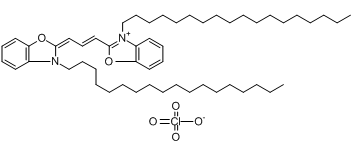All AbMole products are for research use only, cannot be used for human consumption.

DiO is used to label muscle membranes, and the membranes accessible to the dye were observed by confocal laser scanning microscopy. 3,3′-Dioctadecyloxacarbocyanine perchlorate is a cationic oxacarbocyanine dye. The absorption and fluorescence spectra of 3,3'-dioctadecyloxacarbocyanine, a cationic oxacarbocyanine dye have been studied in aqueous and nonaqueous media containing egg phosphatidylcholine (PC) as well as in different solvents of diverse nature. The maximum excitation wavelength is 484nm, and the maximum emission wavelength is 501nm.

J Control Release. 2025 Mar 05;381:113607.
Multifunctional nanoparticles for immune regulation and oxidative stress alleviation in myocarditis
DiO perchlorate purchased from AbMole

ACS Nano. 2023 Sep 12;17(17):16770-16786.
Sequential Targeting Hybrid Nanovesicles Composed of Chimeric Antigen Receptor T-Cell-Derived Exosomes and Liposomes for Enhanced Cancer Immunochemotherapy
DiO perchlorate purchased from AbMole

Front Bioeng Biotechnol. 2023 Feb 21;11:1098172.
Extracellular vesicles secreted by human gingival mesenchymal stem cells promote bone regeneration in rat femoral bone defects
DiO perchlorate purchased from AbMole
| Molecular Weight | 881.72 |
| Formula | C53H85ClN2O6 |
| CAS Number | 34215-57-1 |
| Solubility (25°C) | DMF 5 mg/mL Soluble in DMSO Soluble in Ethanol |
| Storage | 4°C, protect from light, dry, sealed |
| Related Fluorescent Dye Products |
|---|
| 4-MUNANA
4-MUNANA is a substrate of influenza virus neuraminidase (NA) with high selectivity and irreversible reaction. In the enzymatic reaction, 4-MUNANA is hydrolyzed by NA to generate fluorescent 4-methylumbelliferone (4-MU). By detecting the fluorescence intensity of 4-MU, quantitative analysis of NA activity can be achieved. |
| FITC Palmitate
FITC-Palmitate is a fluorescently labelled fatty acid derivative made by chemically coupling fluorescein isothiocyanate (FITC) with a long chain fatty acid, palmitic acid. Due to its combination of fat solubility and green fluorescent signals, it has a variety of uses in biomedical and cell biology experiments. |
| PGSK diacetate (5/6-mixture)
PGSK diacetate (5/6-mixture) is a metal ion-sensitive fluorescent probe that can penetrate cell membranes. PGSK diacetate can react with a variety of metal ions, including Fe2+, Cd2+, Co2+, Ni2+, Zn2+, etc. PGSK diacetate chelates Fe2+, resulting in fluorescence quenching, which can be restored when a membrane-permeable chelator is added, thereby reflecting the changes in the intracellular chelatable iron pool. The excitation/emission maxima of PGSK diacetate are 507/532 nm, respectively. |
| Dextran-Rhodamine B
Dextran-Rhodamine B (RB-Dextran) is a fluorescent marker made by combining rhodamine B fluorescent dye and dextran polysaccharide through a specific chemical reaction. RB-Dextran is a red fluorescent modified dextran polysaccharide formed by chemically labeling rhodamine B onto dextran molecules, which can be used in cell tracing, biofluid dynamics research and other fields, and its fluorescent properties can be used to track the distribution and metabolism of dextran in organisms and other processes. |
| N-Succinimidyl 6-(2,4-Dinitroanilino)hexanoate
N-Succinimidyl 6-(2,4-Dinitroanilino)hexanoate, the DNP-X acid modified by succinimidyl ester, is an amine-reactive building block for developing a probe, which can be recognized by anti-DNP antibodies. |
All AbMole products are for research use only, cannot be used for human consumption or veterinary use. We do not provide products or services to individuals. Please comply with the intended use and do not use AbMole products for any other purpose.


Products are for research use only. Not for human use. We do not sell to patients.
© Copyright 2010-2024 AbMole BioScience. All Rights Reserved.
